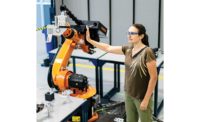Because composite fuselage's are made up of layers of materials, Raytheon needed to find a way to increase production. Using the Viper FPS-3000 Computer Numeric Control (CNC) Fiber Placement System (FPS) developed by Cincinnati Machine (Cincinnati), Raytheon reduced production time to less than a week and the total parts on the Premier I by more than half.
The Viper automates fuselage production by combining a fully programmable 7-axis machine with individualized start, stop and cut control over 24 individual fiber tows. The system is 90 feet long, which is shorter than the first Viper system, which was 60 feet long. The longer length accommodates the longer mandrels for the Horizon Hawker, which is constructed in three sections and are mounted in line for sequential layup enabling one ship set to be produced per cycle. The Premier I is constructed in two sections and are bonded together.
"The automated fiber placement system allows us to build complete fuselages in a fraction of the time required for similar metal structures," said Hansel Tookes, president and CEO of Raytheon Aircraft.
According to Tookes, it takes four people less than a week to produce both sections for the Premier I fuselage on a Viper FPS because it eliminated time intensive hand layup. Each mandrel or mold provides the basic shape of a fuselage section, and the mandrels are mounted horizontally in the system and rotated. The Viper places 24 tows of 1/8-inch carbon fiber pre-impregnated with epoxy over a rotating mandrel in multiple plies to form the interior wall. This is covered with a layer of Nomex, which is a honeycomb core, and then the Viper lays the exterior skin. The final ply on the outer surface is a hybrid fabric of carbon fiber and fine metallic wires to provide protection against lightning strikes.
Plies for the interior and exterior layers are laid at various angles to the previous ply to maximize strength. The Viper maintains tow placement accuracy of better than 0.1 inch while performing laydown at speeds up to 2,000 inches per minute.
The new assembly method eliminated the ribs that are on conventional frame airplanes. This also makes the airplane's internal cabin dimensions 8 inches wider and 7 inches taller. Beside the parts being reduced, it takes 24 to 30 hours of machine operation per fuselage. "Total parts on the Premier I have been reduced by more than half, from 16,000 parts down to 6,000," said Tookes.
According to Tookes, composite materials make the aircraft stronger because the machine places ad-vanced composite tow material rather than workers placing composite fabric. The fuselage is lighter because an aircraft made of composite materials is 20% lighter than one made of aluminum. Another advantage to using carbon fiber is that materials are immune to corrosion and fatigue, which are common problems with materials made of metal. Construction through hand lay-up would entail assembly of smaller parts. One-piece construction using the Viper eliminates this assembly step, saving Raytheon time and money.
Using the Viper, 5% of the carbon fiber material is lost as scrap, Tookes said. By comparison, Raytheon experienced scrap rates of 50% or greater, and on material costing 10 Arial more per pound than aluminum.
"Using the Viper has vastly re-duced part counts, simplified assembly and reduced maintenance," said Tookes. The company plans to purchase two more Vipers to add to the three the company has now.
Cincinnati Machine
(877) CINMACH Reply 12
www.CinMach.com
